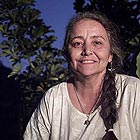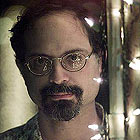|
 |
|
Esta página no está disponible en español. Orlando Sentinel History Of Native People Spurs Debate In Puerto Rico By Matthew Hay Brown | Sentinel Staff Writer December 26, 2003 PHOTOS: RICARDO FIGUEROA/SPECIAL TO THE SENTINEL Why do Puerto Ricans call their island ‘Borinquen'? Borinquen is the name the Taíno, an indigenous people of Puerto Rico, called the island. It means "the land of the brave lord." Christopher Columbus christened the people Taíno, or "peace," because it was the first word they uttered when they saw the conquistador. SOURCE: 'Everything You Need to Know about Latino History' by Himilce Novas OROCOVIS, Puerto Rico -- When she was a girl, Naniki Reyes Ocasio would ask her grandmother about the plants that their people used for medicine, the mounds of soil in which they cultivated the yucca, the celebrations with which they marked the change of the seasons.
"It was prophesied that there would be a time when we would be invisible, invisible even to ourselves," she said, "but that there would come the time when the people would start -- we call it a clearing -- that the weeds would be plucked from our roots, and then the people will emerge again." Reyes is, she said, a modern-day Taíno, a descendant of the indigenous people whom Christopher Columbus encountered on this Caribbean island in 1493, continuing traditions handed down through the generations. Her assertion runs counter to the conventional understanding of history. Schoolchildren in this U.S. commonwealth are taught that the Taíno died out, the victims of slaughter, overwork and disease, within decades of the Spanish arrival. Any who survived would have assimilated into the colonial population, their identity lost forever. Academics say the modern-day Taíno are descended from a 19th-century movement island intellectuals launched to stir nationalism against Spain and are maintained by mainland Puerto Ricans to downplay their African heritage. To the Taíno, that argument is simply the latest in more than 500 years of attempts to eliminate their people. "We know who we are," said Roberto Múcaro Barrero, president of the United Confederation of Taíno People. "The families themselves have kept up. It's a part of our life." Now comes a new study of the island's genetic makeup -- with unexpected results. A geneticist at the University of Puerto Rico has found that more than three in five islanders are descended through the maternal line from American Indian foremothers. The test of mitochondrial DNA does not distinguish among the Taíno and other native peoples. But the results indicate a much greater incidence of indigenous heritage than previously had been imagined. "What I read from it is that Puerto Rican people are basically the children of Indian women," the geneticist, Juan Carlos Martínez Cruzado, said. "The information does not support claims of any particular group of having maintained the culture. Of course, it does not disprove it, either." As many as 2 million When Columbus arrived, the Taíno may have numbered as many as 2 million, spread among what is now Cuba, Jamaica, Haiti, the Dominican Republic and Puerto Rico. They were a peaceful people who grew yucca and cassava, hunted birds and small animals, and produced pottery and baskets. They worshipped spirits, marked the seasons and played a ceremonial ball game that may have resembled soccer. When the Spaniards attempted to put the natives to work, some fled; others rebelled, only to be slaughtered. Many succumbed to smallpox and other diseases introduced by the Europeans. Within decades, the population was near extinction. The question of what happened next lies at the heart of the dispute today. In the conventional view, the Taíno disappeared, leaving behind a few artifacts, a scattering of ceremonial grounds and a handful of words we use today: hammock, hurricane, barbecue, canoe, tobacco, iguana. The modern-day Taíno challenge this interpretation. They say they joined the Spaniards, lived as free peasants, intermarried and carried their traditions forward. The proof, Múcaro said, is in practices still visible today, mound farming, herbal medicine and pottery production among them. "We didn't become Spaniards, and we didn't become Africans," he said. "Africans and Spaniards became part of us." Jalil Sued Badillo, an ethno-historian at the University of Puerto Rico, calls that interpretation "a lot of bull." "There is no biological or historical record of that," Sued said. "As a matter of fact, there is a contrary record. The official Spanish record, historical records, speak of the disappearance of the Taínos." Sued said the island population fell almost 90 percent in the 17th century, to be reconstituted primarily by Africans and Europeans. It with this mix, he said, that produced the 19th-century movement. "Most of the Puerto Rican population was mulatto," he said. "So those that are recycling Taíno-type culture in the colonial period are mulattos." With the 20th-century mass migration from the island to the mainland, Gabriel Haslip Viera said, the revival became a broad movement. "On the mainland, people don't want to be seen as people of African background, and at the same time, they don't want to be identified with the Spaniards," said Haslip, a professor of sociology at the City College of New York. "So then the romanticized Taíno identity becomes desirable as an alternative." Maternal vs. paternal Enter Martínez. His survey of mitochondrial DNA, which traces the maternal line, indicates that 61.3 percent of the population is descended from an Amerindian woman, 27.2 percent from an African and 11.5 percent from a Eurasian.
Martínez said this difference reflects a pattern of intermarriage. "Puerto Ricans are a mixed people, and in terms of sex of the parents, we can talk about basically Indian women and Spanish men with a substantial influx of Africans by both ways," he said. "You're not telling us anything we didn't know," Múcaro said. "Of course, you have the academics who are all up in arms about this because it's their perspective that's being challenged." Academics say Martínez's findings could be explained by the native laborers imported from Mexico and Venezuela in the 18th century -- and, in any event, the genetics of the population say nothing about the continuity of a culture. "That's where the problems begin, in the way certain groups and even the media have portrayed the results as indicating that the Taíno people are somehow alive and well in Puerto Rico," said Jorge Duany, an anthropologist at the University of Puerto Rico. "They're generalizing from a genetic finding to a cultural and even a historical argument, as if being a Taíno were simply a question of having a certain kind of genes." On their 400-acre farm, Reyes and her husband grow coffee, bananas and oranges, corn, root crops and medicinal herbs. They are trying to reintroduce animals such as the jutía, a rodent the Taíno hunted for food, and plants such as the potato-like lerén. Area Taíno hold ceremonies and meet to relearn tradition. "It's really learning about how to be human," she said. "How to be a person that considers other things and other people. . . . We understand that we weren't here to dominate but rather to live in harmony and preserve." Helping build community Beyond the farm, the Taíno are compiling a census and working to restore their language. Reyes is using her legal experience to address items of communal concern: access to ceremonial grounds, the desecration of burial sites and, with other indigenous peoples, reparations and compensation. She is dismissive of the skeptics. "They're searching for the answers to tell them what they want them to tell them," she said. "What you see is a government and a people bent on wanting to maintain their construction of history versus being able to accept the reality. "If you admitted my existence, then you would have to admit that you have been a crass violator of my human rights."
|

 Now a grandmother herself, the former New York attorney has returned to the green hills of Puerto Rico's mountainous spine to work as a healer, to grow food in the old way and to help others remember.
Now a grandmother herself, the former New York attorney has returned to the green hills of Puerto Rico's mountainous spine to work as a healer, to grow food in the old way and to help others remember. A preliminary study of the Y chromosome shows the opposite in the paternal line: Most islanders are descended from Eurasian forefathers, with African heritage coming in second and American Indian third.
A preliminary study of the Y chromosome shows the opposite in the paternal line: Most islanders are descended from Eurasian forefathers, with African heritage coming in second and American Indian third.